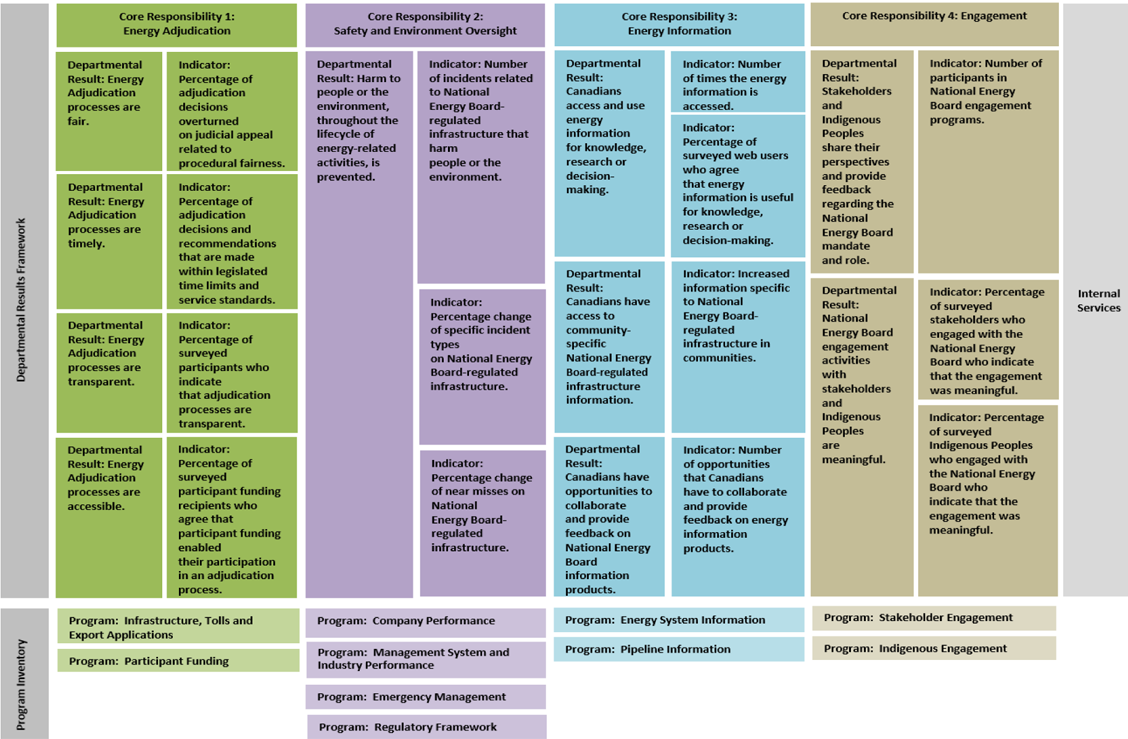Canada Energy Regulator – 2020–21 Departmental Results Report – Additional information
Organizational profile
Appropriate minister[s]: The Honourable Jonathan Wilkinson, P.C., M.P.
Institutional head: Gitane De Silva
Ministerial portfolio: Natural Resources
Enabling instrument[s]: Canadian Energy Regulator Act (CER Act)Footnote 41
Year of incorporation / commencement: 2019
Raison d’être, mandate and role: who we are and what we do
“Raison d’être, mandate and role: who we are and what we do” is available on the CER’s websiteFootnote 42.
For more information on the department’s organizational mandate letter commitments, see the Minister’s mandate letter.Footnote 43
Reporting framework
The CER’s Departmental Results Framework and Program Inventory of record for 2020–21 are shown below.

Graphic description
| Departmental Results Framework | Core Responsibility 1: Energy Adjudication |
Core Responsibility 2: Safety and Environment Oversight |
Core Responsibility 3: Energy Information |
Core Responsibility 4: Engagement |
Internal Services | ||||
| Departmental Result: Energy Adjudication processes are fair. | Indicator: Percentage of adjudication decisions overturned on judicial appeal related to procedural fairness. | Departmental Result: Harm to people or the environment, throughout the lifecycle of energy-related activities, is prevented. | Indicator: Number of incidents related to National Energy Board-regulated infrastructure that harm people or the environment. | Departmental Result: Canadians access and use energy information for knowledge, research or decision-making. | Indicator: Number of times the energy information is accessed. | Departmental Result: Stakeholders and Indigenous Peoples share their perspectives and provide feedback regarding the National Energy Board mandate and role. | Indicator: Number of participants in National Energy Board engagement programs. | ||
| Departmental Result: Energy Adjudication processes are timely. | Indicator: Percentage of adjudication decisions and recommen- dations that are made within legislated time limits and service standards. | Indicator: Percentage change of specific incident types on National Energy Board-regulated infrastructure. | Indicator: Percentage of surveyed web users who agree that energy information is useful for knowledge, research or decision-making. | Departmental Result: National Energy Board engagement activities with stakeholders and Indigenous Peoples are meaningful. | Indicator: Percentage of surveyed stakeholders who engaged with the National Energy Board who indicate that the engagement was meaningful. | ||||
| Departmental Result: Energy Adjudication processes are transparent. | Indicator: Percentage of surveyed participants who indicate that adjudication processes are transparent. | Indicator: Percentage change of near misses on National Energy Board-regulated infrastructure. | Departmental Result: Canadians have access to community-specific National Energy Board-regulated infrastructure information. | Indicator: Increased information specific to National Energy Board-regulated infrastructure in communities. | Indicator: Percentage of surveyed Indigenous Peoples who engaged with the National Energy Board who indicate that the gagement was meaningful. | ||||
| Departmental Result: Energy Adjudication processes are accessible. | Indicator: Percentage of surveyed participant funding recipients who agree that participant funding enabled their participation in an adjudication process. | Departmental Result: Canadians have opportunities to collaborate and provide feedback on National Energy oard information products. | Indicator: Number of opportunities that Canadians have to collaborate and provide feedback on energy information products. | ||||||
| Program Inventory | Program: Infrastructure, Tolls and Export Applications | Program: Company Performance | Program: Energy System Information | Program: Stakeholder Engagement | |||||
| Program: Participant Funding | Program: Management System and Industry Performance | Program: Pipeline Information | Program: Indigenous Engagement | ||||||
| Program: Emergency Management | |||||||||
| Program: Regulatory Framework | |||||||||
Supporting information on the program inventory
Financial, human resources and performance information for the CER’s Program Inventory is available in GC InfoBaseFootnote 44.
Supplementary information tables
The following supplementary information tables are available on the CER’s website:
- Reporting on Green ProcurementFootnote 45
- Details on transfer payment programsFootnote 46
- Gender-based analysis PlusFootnote 47
Federal tax expenditures
The tax system can be used to achieve public policy objectives through the application of special measures such as low tax rates, exemptions, deductions, deferrals and credits. The Department of Finance Canada publishes cost estimates and projections for these measures each year in the Report on Federal Tax Expenditures.Footnote 48 This report also provides detailed background information on tax expenditures, including descriptions, objectives, historical information and references to related federal spending programs as well as evaluations and GBA Plus of tax expenditures.
Organizational contact information
Headquarters Calgary |
210-517 10 Ave SW |
Office: 403-292-4800 |
Montréal Office |
804-1130 rue Sherbrooke O Montréal QC H3A 2M8 |
Office: 514-283-2763 |
Vancouver Office |
219-800 Burrard St Vancouver BC V6Z 0B9 |
Office: 604-666-3975 |
Northern Office |
P.O. Box 2213 115-5101 50 Ave Yellowknife NT X1A 2P7 |
Office: 867-766-8408 |
|
||
|
Email: info@cer-rec.gc.ca |
|
|
||
|
||
|
||
|
||
- Date modified:








